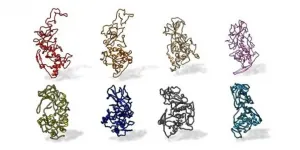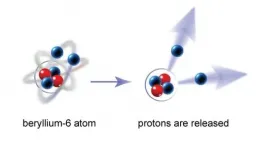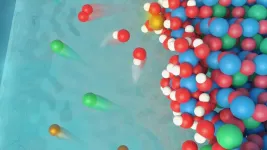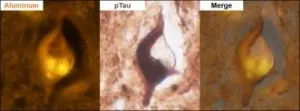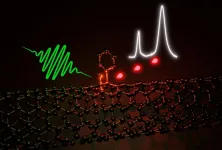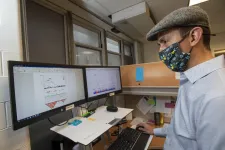(Press-News.org) Washington, DC (April 9, 2021) -- The American Society of Nephrology (ASN) and the National Kidney Foundation (NKF) announce the concurrent publication of "Special Article: Reassessing the Inclusion of Race in Diagnosing Kidney Diseases: An Interim Report from the NKF-ASN Task Force" in the Journal of the American Society of Nephrology (JASN) and the American Journal of Kidney Diseases (AJKD).
The publication in JASN and AJKD provides an essential review of the many challenges relative to identifying and implementing alternative methods to diagnosing kidney diseases. Last month, ASN and NKF asserted that race modifiers should not be included in equations used to estimate kidney function. ASN and NKF also stated that current race-based equations should be replaced by a substitute that is accurate, representative, unbiased, and provides a standardized approach to diagnosing kidney diseases.
In its final report, the task force will recommend the best approach to replace the existing equations for estimating kidney function. As a result, the interim report is the second in a three-step process: 1) agree to replace race-based equations; 2) review the many challenges relative to identifying and implementing alternative methods; and 3) recommend the best approach for replacing existing equations) to accomplishing the goal NKF and ASN established in July 2020 "to examine the inclusion of race in the estimation of GFR and its implications for the diagnosis and subsequent management of patients with, or at risk for, kidney diseases."
NKF and ASN urge institutions not to make any changes to how they estimate kidney function until the task force provides its recommendation for the best approach to replace the existing equations for estimating kidney function. The task force plans to include these recommendations in its final report, which is currently being drafted based on considerable input from patients, trainees, health professionals, and other stakeholders. ASN and NKF commend the task force for its thoughtfulness, thoroughness, time, and effort. Both the interim and final reports will guide the kidney community in developing an evidence-based guideline for practice.
"The use of race in clinical algorithms, such as for the estimation of GFR, normalizes and reinforces the misconception of race as a biological determinant of health and disease. This is not to say that clinicians should ignore race and ethnicity. Doing so would blind us to the disparities and inequities present in health and healthcare. But we must not conflate the societal effects of race and racism on health, healthcare and kidney diseases with physiologic and pathophysiologic determinants of health," said NKF President Paul M. Palevsky, MD, FASN, FNKF.
"Beyond the inclusion of race in clinical algorithms like eGFR, ASN and NKF assert that racism manifests in many aspects of health care," said ASN President Susan E. Quaggin, MD, FASN, who added, "Both organizations commit to providing resources and expertise to the essential job of dismantling systemic racism in kidney care, research, and education."
In addition to publishing the interim report, Josephine P. Briggs, MD, and Harold I. Feldman, MD--the Editors-in-Chief of JASN and AJKD respectively--published a joint editorial, "Race and the Estimation of GFR: Getting it Right" (JASN and AJKD). They assert, "As journal editors, we recognize published research that has emphasized race as a biologic construct has contributed to a failure to address core problems." They add that publishing the interim report is an important step "in the pursuit of effective interventions that will lessen race-based disparities in health. It includes being more cognizant of how reporting of science can perpetuate racism. In this spirit, we are grateful for the opportunity to promote and disseminate the work of the task force."
More than 37 million adults in the United States have kidney diseases. A disproportionate number of these people are Black or African American, Hispanic or Latino, American Indian or Alaska Native, Asian American, and Native Hawaiian or Other Pacific Islander. These Americans also face unacceptable health disparities and inequities in healthcare delivery.
INFORMATION:
The NKF-ASN Task Force on Reassessing the Inclusion of Race in Diagnosing Kidney Diseases welcomes your input to the Interim Report. Healthcare professionals interested in providing comment may do so via this link by Friday, April 30, 2021
About the American Society of Nephrology
ASN leads the fight to prevent, treat, and cure kidney diseases throughout the world by educating health professionals and scientists, advancing research and innovation, communicating new knowledge, and advocating for the highest quality care for patients. ASN has more than 21,000 members representing 131 countries. For more information, please visit http://www.asn-online.org or contact the society at 202-640-4660.
About the National Kidney Foundation
The National Kidney Foundation (NKF) is the largest, most comprehensive, and longstanding patient-centric organization dedicated to the awareness, prevention, and treatment of kidney diseases in the U.S. For more information visit http://www.kidney.org.
Media contacts:
ASN: Christine Feheley, 202-640-4638 Email:
cfeheley@asn-online.org
NKF: Julie Kimbrough,
212-889-2210, ext. 136 Email:
julie.kimbrough@kidney.org
A tiny protein of SARS-CoV-2, the coronavirus that gives rise to COVID-19, may have big implications for future treatments, according to a team of Penn State researchers.
Using a novel toolkit of approaches, the scientists uncovered the first full structure of the Nucleocapsid (N) protein and discovered how antibodies from COVID-19 patients interact with that protein. They also determined that the structure appears similar across many coronaviruses, including recent COVID-19 variants -- making it an ideal target for advanced treatments and vaccines. They reported their results in Nanoscale.
"We discovered new features about the N protein structure that could have large implications in antibody testing ...
Since 2016, a federal regulation has allowed nurse practitioners and physician assistants to obtain a waiver to prescribe buprenorphine, a medication used to treat opioid use disorder as a medication assisted treatment.
But a recent study by Indiana University researchers found the bill, called the Comprehensive Addiction and Recovery Act (CARA), has not greatly increased the amount of nurse practitioners prescribing buprenorphine, especially in states that have further restrictions. The study was published in Medical Care Research and Review.
"Nurse practitioners and physician assistants are an important workforce with a capacity to expand treatment access for those with substance use disorders," said Kosali Simon, ...
Michigan State University's Witold Nazarewicz has a simple way to describe the complex work he does at the Facility for Rare Isotope Beams (frib.msu.edu), or FRIB.
"I study theoretical nuclear physics," said Nazarewicz, John A. Hannah Distinguished Professor of Physics and chief scientist at FRIB. "Nuclear theorists want to know what makes the nucleus tick."
There is a nucleus in every atom. Atoms, in turn, make up matter -- the stuff we interact with every day. But the nucleus is still shrouded in mystery. One of FRIB's goals in creating rare isotopes, or different forms of elements, is to better understand what's going on inside the cores of atoms.
In a new paper for END ...
Led by a South African team at the South African Medical Research Council Centre for Health Economics and Decision Science (PRICELESS-SA) in the School of Public Health at the University of the Witwatersrand, Johannesburg (Wits), and the University of the Western Cape, in partnership with the University of North Carolina, USA, the study was published on 8 April in The Lancet Planetary Health.
South Africa faces an increasing burden of non-communicable diseases (NCDs) such as diabetes, hypertension, cardiovascular disease and cancers - diseases that can be linked to increased consumption of sugar, particularly ...
A clean energy future propelled by hydrogen fuel depends on figuring out how to reliably and efficiently split water. That's because, even though hydrogen is abundant, it must be derived from another substance that contains it -- and today, that substance is often methane gas. Scientists are seeking ways to isolate this energy-carrying element without using fossil fuels. That would pave the way for hydrogen-fueled cars, for example, that emit only water and warm air at the tailpipe.
Water, or H2O, unites hydrogen and oxygen. Hydrogen atoms in the form of molecular hydrogen must be separated out from this compound. That process depends on a key -- but often slow -- step: the oxygen evolution reaction (OER). The OER is what frees up molecular ...
Amsterdam, April 9, 2021 -- This study builds upon two earlier published studies (Mold et al., 2020, Journal of Alzheimer's Disease Reports) from the same group. The new data, also published in the Journal of Alzheimer's Disease Reports, demonstrate that aluminum is co-located with phosphorylated tau protein, present as tangles within neurons in the brains of early-onset or familial Alzheimer's disease (AD). "The presence of these tangles is associated with neuronal cell death, and observations of aluminum in these tangles may highlight a role for aluminum in their formation," explained lead investigator Matthew John Mold, PhD, Birchall Centre, Lennard-Jones ...
The properties of carbon-based nanomaterials can be altered and engineered through the deliberate introduction of certain structural "imperfections" or defects. The challenge, however, is to control the number and type of these defects. In the case of carbon nanotubes - microscopically small tubular compounds that emit light in the near-infrared - chemists and materials scientists at Heidelberg University led by Prof. Dr Jana Zaumseil have now demonstrated a new reaction pathway to enable such defect control. It results in specific optically active defects - so-called sp3 defects - which are more luminescent and can emit single photons, that is, particles of light. The efficient ...
A new study using human genetics suggests researchers should prioritize clinical trials of drugs that target two proteins to manage COVID-19 in its early stages.
The findings appeared online in the journal Nature Medicine in March 2021.
Based on their analyses, the researchers are calling for prioritizing clinical trials of drugs targeting the proteins IFNAR2 and ACE2. The goal is to identify existing drugs, either FDA-approved or in clinical development for other conditions, that can be repurposed for the early management of COVID-19. Doing so, they say, will help keep people with the virus from being hospitalized.
IFNAR2 is the target ...
PHILADELPHIA - Psychosocial stress - typically resulting from difficulty coping with challenging environments - may work synergistically to put women at significantly higher risk of developing coronary heart disease, according to a study by researchers at Drexel University's Dornsife School of Public Health, recently published in the Journal of the American Heart Association.
The study specifically suggests that the effects of job strain and social strain -- the negative aspect of social relationships -- on women is a powerful one-two punch. Together they are associated with a 21% higher risk of developing coronary heart disease. Job strain ...
There are millions of people who face the loss of their eyesight from degenerative eye diseases. The genetic disorder retinitis pigmentosa alone affects 1 in 4,000 people worldwide.
Today, there is technology available to offer partial eyesight to people with that syndrome. The Argus II, the world's first retinal prosthesis, reproduces some functions of a part of the eye essential to vision, to allow users to perceive movement and shapes.
While the field of retinal prostheses is still in its infancy, for hundreds of users around the globe, the "bionic eye" enriches the way they interact with the world on a daily basis. For instance, seeing outlines of objects enables them to move around unfamiliar environments with increased safety.
That is ...
